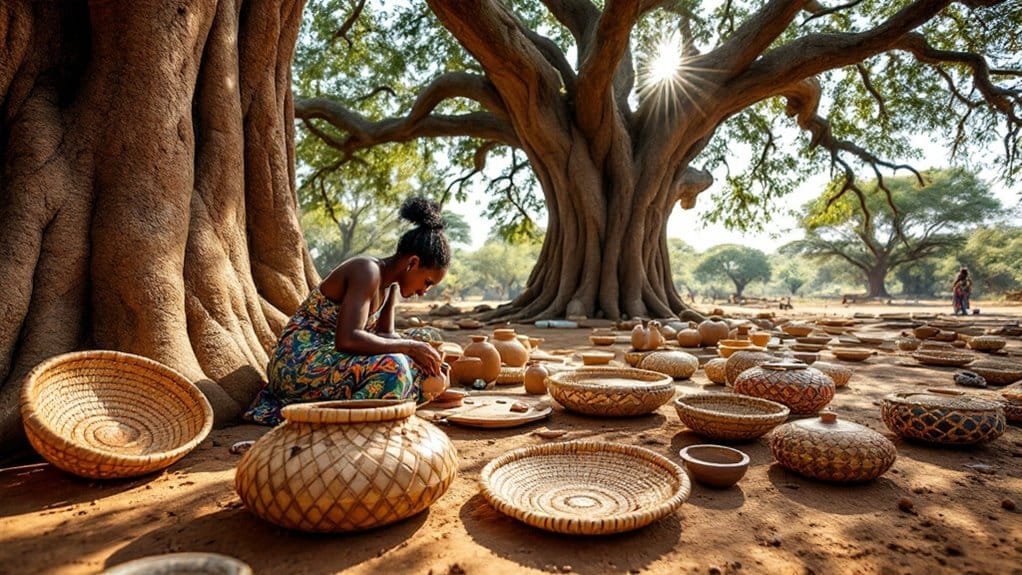Sustainable Indigenous craftsmanship in Africa connects deeply with cultural heritage, showcasing unique traditions while nurturing the environment. By using eco-friendly materials and traditional techniques, artisans create beautiful pieces that reflect local stories and values. This craftsmanship boosts local economies, providing fair wages and stable livelihoods. Each region offers distinct crafts, like Maasai beadwork or Zulu pottery, contributing to a rich tapestry of heritage. These practices not only preserve traditions but also influence global design trends, emphasizing sustainability. If you explore further, you'll uncover the diverse stories and techniques that make this craftsmanship essential for future generations.
Key Takeaways
- Indigenous craftsmanship in Africa preserves cultural heritage by using traditional techniques that reflect local folklore and community narratives.
- Eco-friendly materials and natural dyes used by artisans promote sustainability and reduce environmental impact while supporting local ecosystems.
- Unique regional crafts, such as Maasai beadwork and Ashanti Kente cloth, showcase cultural significance and community values through intricate designs.
- Artisan cooperatives empower communities by creating fair trade opportunities, enhancing livelihoods, and fostering economic development through sustainable practices.
- Collaborations with global brands and high-profile exhibitions elevate African crafts, reshaping aesthetics and promoting storytelling while ensuring equitable compensation for artisans.
Cultural Significance of Craftsmanship
Craftsmanship in Africa is more than just a skill; it's a vibrant expression of cultural identity. Each piece you encounter is steeped in the rich artisanal traditions that reflect the diverse communities across the continent.
The cultural significance of traditional craftsmanship lies in its ability to tell stories, connecting you to the local folklore and ancestral narratives that have shaped generations.
When you admire intricate patterns in woven basketry or textiles, you're witnessing a visual language that conveys societal roles and community values. Beadwork, for instance, symbolizes social status and lineage, with each color and design carrying meaning in ceremonial contexts.
Pottery transcends mere utility; it embodies spiritual beliefs that resonate deeply within communities, marrying functionality with artistry.
Masks and sculptures serve not only as aesthetic expressions but also as essential links to African heritage. They connect contemporary artisans to their roots, reinforcing cultural continuity through storytelling and performance.
As you explore these crafts, you'll find that they're not just art; they're living representations of identity, inviting you to join a shared experience that celebrates the richness of African culture.
Sustainable Practices in Crafting
When you explore sustainable practices in African crafting, you'll find artisans prioritizing eco-friendly materials and local resources.
They skillfully blend traditional techniques with innovative approaches, ensuring their work is both environmentally conscious and culturally rich.
Eco-friendly Material Use
As artisans embrace sustainable practices, they're increasingly turning to eco-friendly materials that reflect both their cultural heritage and environmental responsibility.
By using locally sourced and recycled materials, these creators not only minimize their environmental impact but also foster community resilience. You can see this shift in three significant ways:
- Reclaimed Wood and Natural Fibers: Artisans are crafting sustainable crafts from materials that would otherwise go to waste, creating beautiful pieces while supporting local ecosystems.
- Natural Dyes: Many artisans are opting for natural dyes derived from plants and minerals, stepping away from harmful synthetic options that can damage the environment.
- Traditional Techniques: Methods like handweaving and natural pottery are being revived, emphasizing low-carbon production processes that honor ancestral knowledge.
These eco-friendly practices not only preserve the environment but also enhance the economic viability of local communities.
By supporting artisans committed to sustainability, you join a movement that values both cultural heritage and responsible consumption.
Together, we can embrace a future where craftsmanship and environmental stewardship go hand in hand.
Traditional Techniques Preservation
For generations, artisans in Africa have honed their skills through traditional techniques that embody both cultural heritage and environmental sustainability. By employing age-old practices, local artisans guarantee the preservation of their craftsmanship while promoting sustainable practices. This connection to the past is crucial for cultural continuity, as it fosters a sense of belonging within communities.
To support these artisans, training programs and workshops are established, focusing on traditional techniques preservation. These initiatives not only educate new artisans but also help them adapt eco-friendly methods, like natural dyeing and the use of recycled materials, to meet contemporary demands.
Here's a closer look at the importance of these practices:
| Traditional Techniques | Benefits |
|---|---|
| Natural Dyeing | Eco-friendly color sources |
| Age-old Weaving | Cultural heritage preservation |
| Recycled Materials | Reduced environmental impact |
Local Resource Sourcing
Local resource sourcing stands at the heart of sustainable craftsmanship in Africa, where artisans creatively draw from their surroundings. By utilizing local materials, they not only foster their cultural heritage but also contribute to the economic resilience of their communities.
Here are three key aspects of local resource sourcing:
- Renewable Materials: Artisans often choose materials like bamboo, jute, and terracotta. These options reduce environmental impact and promote local ecosystems' sustainability.
- Natural Dyes: Many craftspeople engage in eco-friendly practices by sourcing natural dyes from plants and minerals. This guarantees their crafting processes remain non-toxic and sustainable.
- Recycled Materials: The use of repurposed fabrics and found objects is growing among artisans who aim to minimize waste. This not only creates unique handcrafted items but also supports the community's commitment to eco-friendly practices.
Economic Impact on Communities
When you support indigenous craftsmanship, you're directly impacting artisans' livelihoods and creating market opportunities that benefit entire communities.
These initiatives not only foster economic growth but also empower local populations, ensuring they can thrive.
Livelihoods for Artisans
In recent years, the handmade crafts sector has emerged as a vital source of income for millions of artisans across Africa, directly impacting their communities.
This vibrant industry not only supports livelihoods for artisans but also helps to preserve cultural heritage and traditional techniques. By engaging in sustainable craftsmanship, you contribute to economic empowerment and the stability of local economies.
Here are three key benefits of this sector:
- Economic Impact: The handicraft sector contributes an estimated $10 billion annually to the African economy, creating jobs and boosting local trade initiatives.
- Fair Trade Practices: These practices guarantee artisans receive equitable compensation, fostering community stability and enhancing cultural pride.
- Cultural Preservation: Promoting local crafts allows communities to sustain traditional skills, making sure that future generations can continue these practices.
Market Opportunities Creation
The rise of the handmade crafts sector has opened up numerous market opportunities that profoundly impact African communities. As you explore this vibrant landscape, you'll see how traditional crafts, like textiles and beadwork, aren't just beautiful; they're lifelines for many artisans.
These handmade crafts contribute profoundly to local economies, fostering sustainable economic development through their sale.
With the increased demand for unique handmade goods, cooperatives have sprung up, empowering communities and creating fair trade opportunities. This means artisans like you can earn fair wages while ensuring safe working conditions.
The export of these crafts introduces your culture to a global audience, generating income and raising awareness of Africa's rich heritage.
Moreover, eco-friendly practices, such as using recycled materials, enhance the market viability of traditional crafts. It's not just about craftsmanship; it's about building a community that values sustainability and inclusivity.
Artisan-focused initiatives create lasting impacts, allowing you to take pride in your work while contributing to the economic stability of your community. Together, we can celebrate and support the artistry that defines us, creating a brighter future for all.
Community Development Initiatives
Community development initiatives centered around sustainable indigenous craftsmanship have transformed the lives of millions of artisans across Africa. These programs not only provide livelihoods but also foster economic stability within local economies.
By supporting traditional skills and promoting fair trade partnerships, artisans receive equitable compensation, which nurtures their communities and cultural heritage.
Here are three key impacts of these initiatives:
- Empowerment of Artisans: Artisans gain the skills and resources needed to thrive economically, creating a sense of purpose and belonging.
- Youth Engagement: Educational programs help local youth learn traditional skills, ensuring the preservation of cultural heritage for future generations.
- Eco-friendly Practices: By promoting the use of local resources and sustainable methods, these initiatives cultivate resilience against global market fluctuations.
Through these efforts, sustainable craftsmanship flourishes, generating substantial income for craft markets and reducing poverty levels.
As you support these initiatives, you're not just buying a product; you're investing in a community and its rich cultural legacy. Together, we can uplift and empower artisans, creating a brighter, more sustainable future for all.
Regional Diversity in Craft Techniques
Africa's vibrant tapestry of craftsmanship showcases a stunning array of regional techniques, each deeply rooted in local culture and resources. African craftsmanship continues to thrive, reflecting the unique identities of various communities.
For instance, the intricate beadwork of the Maasai community in Kenya isn't just art; it tells stories of cultural significance and social status.
In West Africa, the Ashanti people's Kente cloth weaving uses specific patterns and colors that convey proverbs and historical narratives, weaving together a rich storytelling tradition.
Similarly, the Dogon people in Mali create wooden masks that embody spiritual and ancestral themes, integrating cultural beliefs into their craftsmanship.
The Zulu people's pottery employs natural materials like mud, blending artistry with functionality while honoring traditional techniques.
This sustainable approach is mirrored in Tanzania, where sisal is used in basket weaving, showcasing how local resources shape not only craft but also community practices.
Through these diverse techniques, you'll see how craftsmanship fosters belonging, connecting you to the essence of Africa's cultural heritage.
Each piece is a reflection of the regional diversity that enriches this beautiful continent.
Notable Examples of Indigenous Crafts
Exploring indigenous crafts reveals a treasure trove of cultural expressions that highlight the rich heritage of various African communities.
These crafts not only showcase artistry but also embody the values and beliefs of the societies that create them.
Here are three notable examples:
1. Kente Cloth: Originating from the Akan people of Ghana, this vibrant, handwoven textile communicates proverbs and social status, deeply reflecting the region's cultural heritage.
2. Wooden Masks: In the Democratic Republic of Congo, skilled artisans carve intricate Wooden Masks that serve both decorative and spiritual purposes.
These masks embody ancestral beliefs and storytelling traditions, connecting the present to the past.
3. Beadwork: The Maasai community in Kenya and Tanzania is renowned for its elaborate Beadwork, where each color and pattern conveys specific meanings related to identity and social roles, showcasing the cultural significance of their crafts.
Global Influence on Contemporary Design
The fusion of traditional African craftsmanship with contemporary design is reshaping the global aesthetic landscape. You'll find that this blend not only embraces sustainable design but also highlights the artistry and narratives woven into each piece.
Global fashion brands are increasingly collaborating with African artisans to incorporate indigenous motifs, celebrating cultural significance while promoting fair trade and economic empowerment.
With the rise of slow fashion, there's a growing demand for unique, handmade items that tell a story. Designers are embracing traditional techniques to create eco-friendly products, often using recycled materials and natural dyes. This commitment to environmental responsibility resonates deeply with those who value authenticity and connection to culture.
High-profile exhibitions and international art fairs are showcasing the impact of African craftsmanship on global design trends, fostering appreciation for these rich traditions.
As you explore this evolving landscape, you'll see how the integration of these elements not only preserves cultural heritage but also invites you to be a part of a movement that honors both the past and the future.
Embrace this journey, and find belonging in the beauty of sustainable indigenous craftsmanship.
Preserving Heritage Through Artisanship
Through generations, artisans have safeguarded their cultural heritage, creating pieces that reflect their communities' histories and values. By embracing traditional techniques, they preserve not just their craftsmanship but also the cultural identity woven into each creation.
Here's how artisanship plays a significant role in preserving heritage:
- Sustainable Practices: Many artisans utilize locally sourced materials and recycled resources, minimizing environmental impact while honoring their cultural values.
- Storytelling: Each handcrafted item often incorporates indigenous symbols and narratives, allowing artisans to communicate their community's stories through textiles, beadwork, and pottery.
- Economic Driver: Craftsmanship serves as an essential economic driver, providing livelihoods for millions and fostering community development through the sale of handmade goods.
Artisanship isn't merely about creating beautiful objects; it's about connecting you to a larger narrative of belonging and identity.
By supporting local artisans, you contribute to preserving heritage and champion sustainable practices. Collaborative initiatives with international organizations further bolster these efforts, ensuring that traditional craftsmanship thrives for future generations.
In this way, every purchase you make becomes a step towards preserving the rich tapestry of Africa's heritage.
Frequently Asked Questions
How Can I Support Indigenous Artisans and Their Crafts?
To support indigenous artisans and their crafts, you can start by exploring fair trade online marketplaces that showcase their work.
Engage with artisan cooperatives to guarantee ethical sourcing and community outreach.
Participate in skill sharing workshops to learn about their techniques and promote design innovation.
Build local partnerships to amplify their storytelling techniques and preserve their cultural heritage.
Your support not only empowers artisans but also fosters a sense of belonging within their communities.
What Materials Are Commonly Used in Indigenous Craftsmanship?
Indigenous craftsmanship is like a vibrant tapestry, woven with diverse materials.
You'll find natural fibers and plant dyes creating stunning textiles, while clay pottery showcases the earth's bounty.
Recycled materials breathe new life into art, and wood carving reflects nature's beauty.
Beadwork techniques add intricate detail, and metalwork traditions shine with history.
Stone sculpture stands strong, honoring the past, as traditional weaving binds communities together, creating a sense of belonging through shared heritage.
Are There Workshops to Learn These Traditional Techniques?
Yes, there are plenty of traditional workshops where you can learn these techniques!
You'll gain hands-on experience through mentorship programs that focus on skill transmission and cultural preservation. Many artisan cooperatives encourage community involvement, creating a supportive environment.
You can also find immersive learning opportunities at craft festivals or explore online courses that connect you with experts.
Embrace the chance to deepen your connection to these rich traditions and feel a sense of belonging.
How Does Climate Change Affect Indigenous Crafting Practices?
Climate change impacts indigenous crafting practices by altering resource availability and driving material scarcity.
You'll notice how artisans adapt their traditional knowledge to address these challenges, fostering resilience in their craftsmanship.
As biodiversity loss occurs, the cultural adaptation becomes essential for survival.
You might see innovative techniques emerging from these livelihood challenges, where environmental sustainability takes center stage, showcasing the strength and creativity of communities committed to preserving their heritage and skills.
What Role Do Women Play in Indigenous Craftsmanship?
In indigenous craftsmanship, women play a crucial role, shaping cultural significance and preserving heritage.
They're often the backbone of skill transmission, passing traditional knowledge to the next generation. By engaging in these crafts, women experience economic empowerment, fostering community cohesion and challenging gender roles.
Their artistic expression enriches the craft's social impact, ensuring craft preservation thrives.
When you support these artisans, you're embracing a legacy that strengthens both identity and belonging within the community.
Conclusion
In the vibrant tapestry of Africa's heritage, indigenous craftsmanship symbolizes resilience and creativity. By embracing sustainable practices, you're not just preserving these art forms; you're weaving a future rich with culture and community. Each handcrafted piece tells a story, echoing the voices of generations past. As you support these artisans, you're planting seeds of economic growth and cultural pride, ensuring that the beauty of Africa's craftsmanship continues to bloom for years to come.








